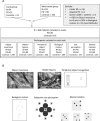Assessing cognitive dysfunction in Parkinson's disease: An online tool to detect visuo-perceptual deficits
- PMID: 29473691
- PMCID: PMC5901022
- DOI: 10.1002/mds.27311
Assessing cognitive dysfunction in Parkinson's disease: An online tool to detect visuo-perceptual deficits
Abstract
Background: People with Parkinson's disease (PD) who develop visuo-perceptual deficits are at higher risk of dementia, but we lack tests that detect subtle visuo-perceptual deficits and can be performed by untrained personnel. Hallucinations are associated with cognitive impairment and typically involve perception of complex objects. Changes in object perception may therefore be a sensitive marker of visuo-perceptual deficits in PD.
Objective: We developed an online platform to test visuo-perceptual function. We hypothesised that (1) visuo-perceptual deficits in PD could be detected using online tests, (2) object perception would be preferentially affected, and (3) these deficits would be caused by changes in perception rather than response bias.
Methods: We assessed 91 people with PD and 275 controls. Performance was compared using classical frequentist statistics. We then fitted a hierarchical Bayesian signal detection theory model to a subset of tasks.
Results: People with PD were worse than controls at object recognition, showing no deficits in other visuo-perceptual tests. Specifically, they were worse at identifying skewed images (P < .0001); at detecting hidden objects (P = .0039); at identifying objects in peripheral vision (P < .0001); and at detecting biological motion (P = .0065). In contrast, people with PD were not worse at mental rotation or subjective size perception. Using signal detection modelling, we found this effect was driven by change in perceptual sensitivity rather than response bias.
Conclusions: Online tests can detect visuo-perceptual deficits in people with PD, with object recognition particularly affected. Ultimately, visuo-perceptual tests may be developed to identify at-risk patients for clinical trials to slow PD dementia. © 2018 The Authors. Movement Disorders published by Wiley Periodicals, Inc. on behalf of International Parkinson and Movement Disorder Society.
Keywords: Parkinson's disease; hallucinations; perception; signal detection theory; vision.
© 2018 The Authors. Movement Disorders published by Wiley Periodicals, Inc. on behalf of International Parkinson and Movement Disorder Society.
Figures



Similar articles
-
Visuo-cognitive dysfunctions in Parkinson's disease.Clin Neurosci. 1998;5(2):147-52. Clin Neurosci. 1998. PMID: 10785841 Review.
-
Visual dysfunction in Parkinson disease without dementia.Neurology. 2005 Dec 27;65(12):1907-13. doi: 10.1212/01.wnl.0000191565.11065.11. Epub 2005 Nov 9. Neurology. 2005. PMID: 16282276
-
Home-based online line bisection test detects visuo-spatial neglect and pseudoneglect in Parkinson's disease.Parkinsonism Relat Disord. 2025 Jan;130:107195. doi: 10.1016/j.parkreldis.2024.107195. Epub 2024 Nov 8. Parkinsonism Relat Disord. 2025. PMID: 39541723
-
Attentional and perceptual impairments in Parkinson's disease with visual hallucinations.Parkinsonism Relat Disord. 2010 May;16(4):270-4. doi: 10.1016/j.parkreldis.2010.01.003. Epub 2010 Feb 13. Parkinsonism Relat Disord. 2010. PMID: 20153970
-
Visual dysfunction in Parkinson's disease.Brain. 2016 Nov 1;139(11):2827-2843. doi: 10.1093/brain/aww175. Brain. 2016. PMID: 27412389 Free PMC article. Review.
Cited by
-
Numerosity estimation of virtual humans as a digital-robotic marker for hallucinations in Parkinson's disease.Nat Commun. 2024 Mar 12;15(1):1905. doi: 10.1038/s41467-024-45912-w. Nat Commun. 2024. PMID: 38472203 Free PMC article.
-
Aberrant functional connectivity of resting state networks related to misperceptions and intra-individual variability in Parkinson's disease.Neuroimage Clin. 2020;25:102076. doi: 10.1016/j.nicl.2019.102076. Epub 2019 Nov 5. Neuroimage Clin. 2020. PMID: 31794926 Free PMC article.
-
Organisational and neuromodulatory underpinnings of structural-functional connectivity decoupling in patients with Parkinson's disease.Commun Biol. 2021 Jan 19;4(1):86. doi: 10.1038/s42003-020-01622-9. Commun Biol. 2021. PMID: 33469150 Free PMC article.
-
Fiber-specific white matter reductions in Parkinson hallucinations and visual dysfunction.Neurology. 2020 Apr 7;94(14):e1525-e1538. doi: 10.1212/WNL.0000000000009014. Epub 2020 Feb 24. Neurology. 2020. PMID: 32094242 Free PMC article.
-
Spatial judgment in Parkinson's disease: Contributions of attentional and executive dysfunction.Behav Neurosci. 2019 Aug;133(4):350-360. doi: 10.1037/bne0000329. Behav Neurosci. 2019. PMID: 31294590 Free PMC article.
References
-
- Williams‐Gray CH, Mason SL, Evans JR, et al. The CamPaIGN study of Parkinson's disease: 10‐year outlook in an incident population‐based cohort. J Neurol Neurosurg Psychiatry 2013;84(11):1258‐1264. - PubMed
-
- Folstein MF, Folstein SE, McHugh PR. “Mini‐mental state”. A practical method for grading the cognitive state of patients for the clinician. J Psychiatr Res 1975;12(3):189‐198. - PubMed
Publication types
MeSH terms
Grants and funding
LinkOut - more resources
Full Text Sources
Other Literature Sources
Medical

